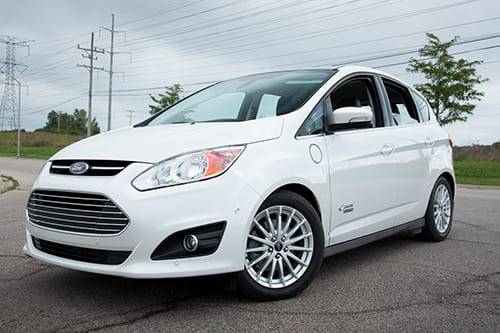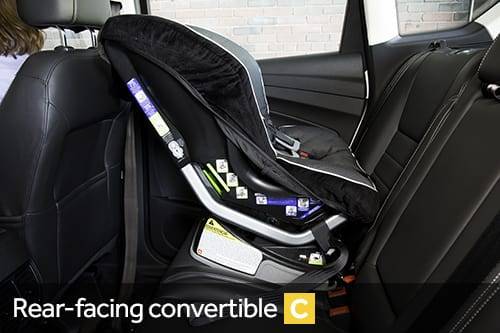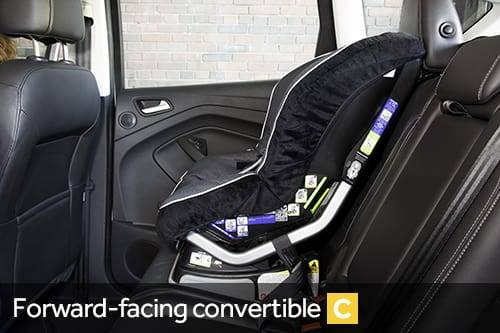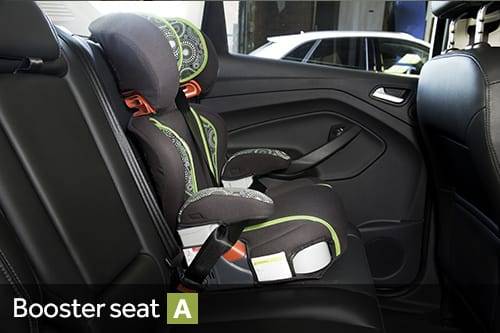2014 Ford C-Max Energi: Car Seat Check


The Ford C-Max Energi hatchback is a fun-to-drive hybrid that Cars.com reviewer Aaron D. Bragman said “delivers comfort, style and efficiency,” but warned that it “compromises cargo capacity.” That’s not all that the 2014 C-Max Energi has had to compromise.
Parents who purchased the C-Max Energi hoping for convenient car-seat installation might be disappointed with it. Although the 2014 version earns a couple of A’s for the easy install of our booster and infant seats, the rest of its report card looks like the answer sheet of a high school student guessing on every question of a multiple-choice test: C, C, C … see what we mean below.
How many car seats fit in the second row? Two
What We Like
- There are two sets of lower Latch anchors in the outboard seats, which are recessed into the seat bight, and three top tether strap anchors on the seatback for which Ford has specific use instructions; for outboard seats, you must route the strap under the head restraints (which are removable), between the restraint’s posts, and for the middle seat the tether strap goes over the head restraint to the strap.
- Our rear-facing infant seat installed with ease thanks to its hooklike connectors, with a simple Latch connection and no need to move the front passenger seat forward.
- Our booster seat also fit well with the head restraint removed; the seat belt buckles are on stable bases, making them easy to use for younger kids.
What We Don’t
- Low, stable seat belt buckles blocked Latch access for the inboard anchors and proved difficult to use with the convertible car seat’s rigid Latch connectors.
- We learned that we had to first connect to the inboard anchor with both the rear- and forward-facing convertible seats’ rigid Latch connectors, and then install the outboard anchor; we discovered this after struggling for several minutes to get at the difficult-to-access anchor. Although we ultimately managed to get the seat installed without having to move the front passenger seat forward, the bottom line is: This is a poor setup.





Grading Scale
A: Plenty of room for the car seat and the child; doesn’t impact driver or front-passenger legroom. Easy to find and connect to Latch and tether anchors. No fit issues involving head restraint or seat contouring. Easy access to the third row.
B: Plenty of room. One fit or connection issue. Some problems accessing third row when available.
C: Marginal room. Two fit or connection issues. Difficult to access third row when available.
D: Insufficient room. Two or more fit or connection issues.
F: Does not fit or is unsafe.
About Cars.com’s Car Seat Checks
Editors Jennifer Geiger, Jennifer Newman and Matt Schmitz are certified child safety seat installation technicians.
For the Car Seat Check, we use a Graco SnugRide Classic Connect 30 infant-safety seat, a Britax Marathon convertible seat and Graco TurboBooster seat. The front seats are adjusted for a 6-foot driver and a 5-foot-8 passenger. The three child seats are installed in the second row. The booster seat sits behind the driver’s seat, and the infant and convertible seats are installed behind the front passenger seat.
We also install the forward-facing convertible in the second row’s middle seat with the booster and infant seat in the outboard seats to see if three car seats will fit; a child sitting in the booster seat must be able to reach the seat belt buckle. If there’s a third row, we install the booster seat and a forward-facing convertible. To learn more about how we conduct our Car Seat Checks, go here.
Parents should also remember that they can use the Latch system or a seat belt to install a car seat, and that Latch anchors have a weight limit of 65 pounds, including the weight of the child and the weight of the seat itself.
Cars.com photos by Evan Sears

Former Assistant Managing Editor-News Matt Schmitz is a veteran Chicago journalist indulging his curiosity for all things auto while helping to inform car shoppers.
Featured stories

15-Year Car Loans Aren’t a Thing, But Americans Are Getting More Comfortable With Long Loan Terms

2025 Kia Telluride Review: Rougher Roads Ahead



